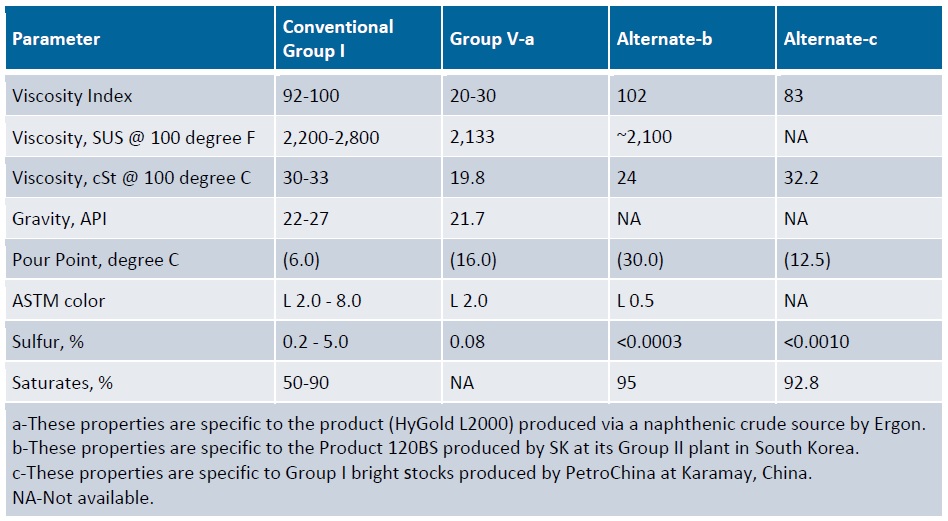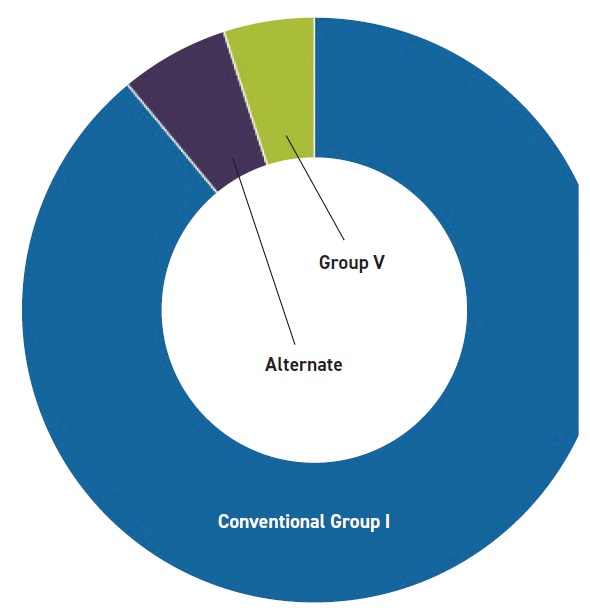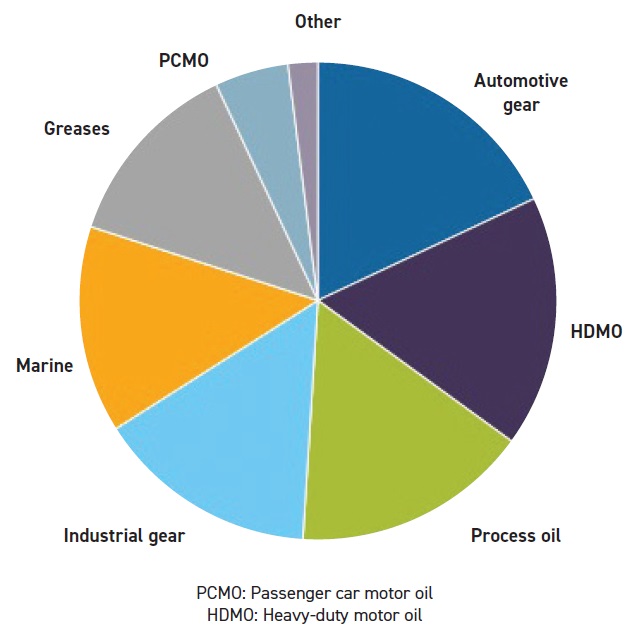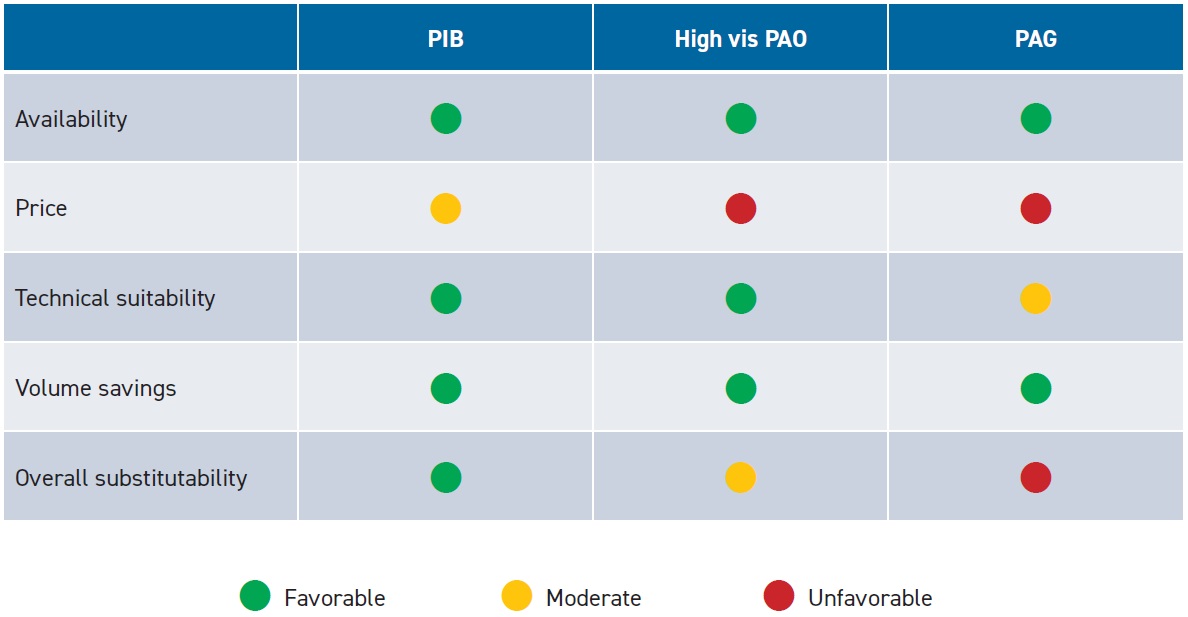Bright stocks are classified into three categories: Group I, Group V and alternate.
The demand for Group I, the most-used base stock, is declining due to changing technical requirements, mainly in automotive engines.
Synthetics are potential bright stock alternatives but can have cost and technical issues.
Bright stock is a high-viscosity lubricant base stock manufactured from the asphaltic residue that remains when lighter fuels and lubricant components are distilled from crude oil. This article classifies bright stocks into three broad categories based on the technical properties of the final product and production schemes (
see Table 1):
Table 1. Typical Specifications of Different Types of Bright Stocks (Table courtesy of Kline & Co.)

1.
Conventional API Group I bright stocks. These are bright stocks produced from conventional API Group I refineries using paraffinic crude and having a propane deasphalting (PDA) unit.
2.
Group V bright stocks. These high-viscosity base stocks are derived from a naphthenic feedstock but have a lower viscosity index, less than 80.
3.
Alternate bright stocks. This includes all bright stocks not covered in either of the above categories. However, the final product quality matches that of either Group I or Group II. Broadly there are two examples of bright stocks produced in this category:
a.
Using paraffinic crude. SK is the only refinery that produces bright stocks using a paraffinic crude source and a non-conventional bright stock production scheme. This product has API Group II characteristics.
b.
Using naphthenic crude. PetroChina produces bright stocks at its Karamay, China, refinery using a naphthenic crude source, but the product has properties like those of API Group II products. Ergon in the U.S. has upgraded its production process at its Vicksburg, Miss., refinery to produce bright stocks from a naphthenic crude source. The product has technical properties like that of API Group I products.
Bright stock demand and supply
Conventional API Group I bright stocks are the most widely available bright stocks across the world as this production scheme remains well established. Group V bright stocks are associated with a few refineries that produce high-viscosity products. As there are only a few refineries producing naphthenic base stocks, the availability and consumption of this set of bright stocks mostly remains a regional phenomenon. This holds true for alternate bright stocks, which are currently produced only by a limited number of refineries. Kline estimates that the global bright stock consumption of all three types of bright stocks stands at around 2.7 million tonnes in 2017 (
see Figure 1).
 Figure 1. Global bright stock consumption of all three types of bright stocks stands around 2.7 million tonnes in 2017. (Figure courtesy of Kline & Co.)
Figure 1. Global bright stock consumption of all three types of bright stocks stands around 2.7 million tonnes in 2017. (Figure courtesy of Kline & Co.)
Historically conventional Group I bright stocks have been an inevitable casualty of the Group I capacity shutdowns and conversions. The demand for Group I base stocks, especially lighter grades, have been declining across the world due to changing technical requirements, mainly in automotive engines. Modern day automotive engine oils performance requirements cannot be met by Group I. Hence, they have been substituted by higher quality Group II/III and polyalphaolefins (PAO) base stocks. This phenomenon, earlier limited to the developed markets of North America and West Europe, is now observed in other markets in Asia-Pacific and other regions.
There also is an oversupply of lighter Group II and Group III base stocks, which increases substitution of lighter Group I grades even from applications such as hydraulic fluids where there is no such technical demand for Group II/Group III. As the competition to lighter Group I grades became fierce from Group II and Group III lighter grades, many Group I plants shut down during the past two decades. A number of these plants had bright stocks facilities that also shut down. Kline estimates that during the period from 1997-2017, about 1.3-1.4 million tonnes of bright stock capacity shut down.
Bright stocks are most often used in applications where lubrication is needed at high temperatures or under heavy stress and load conditions. Lubricants with a high percentage of bright stocks in their formulations include monograde engine oils, gear oils for automotive and industrial applications, marine cylinder oils, greases and process oils used in the tire and rubber industries (
see Figure 2).
 Figure 2. Global bright stock demand by product type, 2017. (Figure courtesy of Kline & Co.)
Figure 2. Global bright stock demand by product type, 2017. (Figure courtesy of Kline & Co.)
Bright stock is used to formulate heavier grades of automotive lubricants such as monograde engine oils and gear oils. Within the engine oil segment, much of the markets in North America, Western Europe and a few developed and developing markets in Asia-Pacific already have transitioned from use of monograde oils to lighter multi-grade oils. These lighter multi-grade oils do not require any bright stock in their formulations. As a result, the demand for bright stock from this application has declined. However, markets in Africa and the Middle East, South America, Eastern Europe and parts of the Asia-Pacific region still consume monograde oils for passenger cars and heavy-duty vehicles. Because of this, these markets have considerable demand for monograde oils for blending automotive engine oils.
Within automotive gear oils, SAE 80W-90 and SAE 85W-140 are the major grades that consume bright stock. While the requirement of bright stock in SAE 80W-90 is around 25%-30% of the blend, the share of bright stocks in SAE 85W-140 is quite high in the overall formulation. As the demand for gear oils, especially in heavy-duty applications, is skewed toward SAE 80W-90 and 85W-140 oils, automotive gear oils represent a significant portion of the bright stock demand. This segment will continue to remain a significant proponent of global bright stock demand as no major changes with regards to viscosity mix in the global automotive gear oil demand are expected, especially in developing markets.
Marine cylinder oil is a major contributor to the global bright stock demand. These oils generally have a viscosity of SAE 50, which provides the necessary requirements such as film strength to protect cylinder liners. Blenders are making efforts to develop the market for SAE 40 marine cylinder oil grade; however, SAE 50 is still the most-used grade of marine cylinder oil across the world. One major factor impacting the global marine industry is the International Maritime Organization’s guidelines mandating sulfur emissions from ships to be reduced to 0.5% m/m (or mass by mass), effective Jan. 1, 2020. At present, contribution of cylinder oils in the overall sulfur emission is small as compared to that from fuel. Hence, ship owners’ primary focus is toward using low-sulfur fuel and after-treatment devices.
The primary use of bright stocks in a grease formulation is to increase viscosity. The applications where greases are used do not have fluctuations in operating temperatures (i.e., the temperature profile in the application is relatively flat); hence, when greases are meant to be used in high temperatures they are blended with thickeners. Mechanical stability and adhesiveness (ability to maintain its consistency after shearing), which are critical properties for greases, are not achieved using bright stock in a formulation. Instead, these properties are dependent on thickeners and sometimes additives. Hence, the demand growth for bright stocks in greases is not proportional to the demand growth for greases.
Rubber process oils or rubber extender oils are used in rubber and rubber products manufacturing to improve the processing of rubber compounds and increase the bulk of the rubber to reduce its cost. They are classified as paraffinic, naphthenic and aromatic types, based on the composition of the base stock. Rubber extender oils are selected for their solvency properties and used in the manufacture of synthetic rubber and elastomers. Rubber and rubber extender oils are compounded with upward of 50% bright stock.
In terms of regional demands, Asia-Pacific is the largest contributor to the global bright stocks demand. While North America and Europe account for a larger share in the global finished lubricant demand, their contribution to global bright stock demand is relatively smaller as these markets have lower demand of monograde automotive engine oils.
In 2017 the supply for bright stock marginally exceeded demand, resulting in a very small surplus on the overall level. However, the situation differs by regions. While Asia-Pacific, Africa and the Middle East have wide deficits, Europe and North America have surpluses that are exported to other regions.
Kline forecasts the global demand for bright stocks will decline at a CAGR of 0.1%-0.2% over the period from 2017-2027. The trend of shutting down high-cost Group I plants will continue in the future, resulting in the decline in global bright stock capacity. Moreover, the bright stock production will be limited by lower operating rates of Group I refineries as they face a declining market. Hence, the decline in supply will be even sharper than the decline in demand, resulting in a deficit of around 250-300 kilotonnes by 2027.
Substitute products
Kline & Co. anticipates the bright stock deficit to be met with the help of various substitute products. An evaluation of several products such as polyisobutylenes (PIBs), high-viscosity polyalphaolefins (hi-vis PAOs) and polyalkylene glycols (PAGs) based on technical suitability, compatibility issues, prices, consumer behavior and availability of these products suggests that PIB would be a key beneficiary of the emerging bright stock deficit.
PIBs are available in a wide range of viscosities and have a very high viscosity index. Due to its high viscosity, PIBs often result in volume savings as one part of a PIB can replace around three to five parts of bright stocks. To adjust the final viscosity of the product, usually a 500 N oil is required. As PIBs do not produce smoke, they can be preferred in applications where smoke is an issue due to lubricant burning. On the other hand, PIBs have inferior solvency compared to conventional Group I bright stocks, which could limit their use in applications where additive solvency is desired. However, the lack of additive solvency can be addressed by introducing other blend components such as naphthenic oils or alkylates.
In terms of technical suitability, high-viscosity PAOs are the best fit to replace bright stocks. However, PAOs’ very high prices make them an unattractive alternative. The current prices of high-viscosity PAOs are almost three to four times that of bright stocks. For sealed-for-life applications, like gearboxes (especially synthetic lubricants), and some applications having low serviceability, PAOs could be well used in place of bright stocks because, in that scenario, price becomes less significant, and continual operation of the machinery becomes critical. Whatever substitution of bright stocks happens by PAOs, it will primarily be driven by the need for synthetic lubricants for better performance (
see Table 2).
Table 2. Comparison of Various Substitute Products (Table courtesy of Kline & Co.)

PAGs are produced in a wide range of viscosities, have low pour points and resist varnish formation. However, conventional PAGs have a big disadvantage in that they have poor miscibility with oil-based fluids. Hence, the use of PAGs as co-base fluid with other base stocks is limited. Moreover, due to its high-solvency property, the additive technology for PAGs becomes completely different, thus warranting a complete reformulation. Therefore, PAGs will be able to address a very small fraction of the bright stock deficit.
Conclusion
The bright stock market faces its own challenges arising from changing demand patterns and limited supply. This shortfall in the supply of bright stock has resulted in higher prices of bright stocks. It also has resulted in growth in supply of similar molecules (high-viscosity base stocks), which has helped bridge the deficit. Overall, the demand outlook for bright stock is negative for automotive engine oils, but demand is expected to remain firm from industrial oils.
Despite these challenging conditions, the market provides opportunities to several stakeholders. The market presents growth opportunities for producers of alternate products along with producers of alternate and Group V bright stock. Though there isn’t any news of a new alternate bright stock capacity now, any new such plan will ease the market. Some of the existing well-run plants also can add to the supply by debottlenecking their existing facilities.